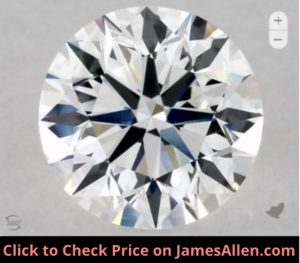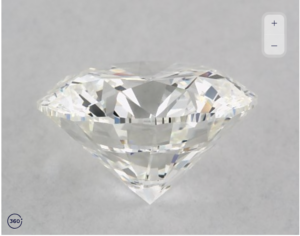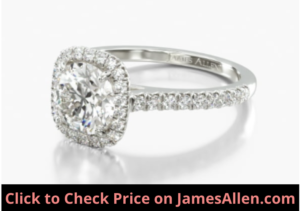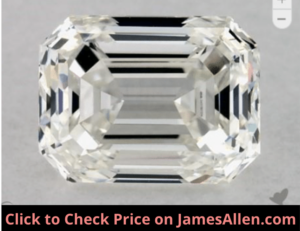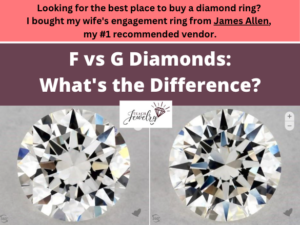
F and G diamonds are positioned toward the top of the scale developed by the Gemological Institute of America (GIA) to identify color grade.
The main difference between F and G color diamonds is G diamonds show slightly more yellow compared to F, which puts them in the “near colorless” category. Buyers pay premiums for F diamonds, even though the two often appear identical to the naked eye.
To help you decide which is the right choice, we’ll compare F versus G diamonds, including an overview of each, three important distinctions, and similarities.
What are F Color Diamonds?
F color diamonds are the third highest position on the GIA color scale. They fall within the colorless section but show more yellow compared to D and E diamonds.
On the scale below, I’ve highlighted where F diamonds land in relation to other grades.

Its qualities place it one letter grade above G diamonds.
Even though F diamonds don’t earn the highest mark, it’s often difficult to find any flaws related to its color.
Take this example of a one-carat, F color diamond in high resolution.
It’s from the vendor where I bought my wife’s engagement ring.
No matter which angle you view it from, the yellow is difficult to find.
Even when it’s placed next to the D color diamond below, they’re indistinguishable.
But the difference is apparent when viewed with magnification. When gemologists determine its color grade, they place it under 10x magnification and scan back and forth. They’ll also compare it to “master stones,” which represent the ideal version of each color.
So while the gemologist found a hint of yellow in the F diamond, the D diamond was clean in every way.
What are G Color Diamonds?
G color diamonds are directly below F on the color scale.
It’s the fourth highest position, above H, I, and J.
Even though there’s a whole category of diamonds with less color, G diamonds are still a rare find. Most diamonds show significant color, which is why buyers pay a premium for any lacking that trait.
As a counter example, check out the diamond below that earned a K color grade.
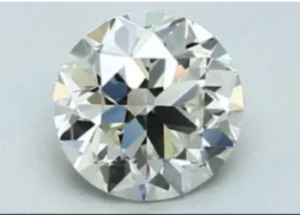
Yellow is visible at every angle.
Now look at this G diamond, which offers tremendous value.
If you didn’t know its color grade, you would think it earned the highest designation.
Placing them side by side demonstrates the superior quality of G diamonds versus ones in lower categories.
But the yellow tints are more obvious under 10x magnification. In fact, gemologists can spot them easily with a jewelers loupe.
If they were more hidden, the diamond would earn a colorless grade instead of G.
How are F and G Color Diamonds Different?
1. G Diamonds Offer Better Value
As a buyer, don’t be too concerned with the specific grade a diamond receives.
Instead, prioritize how it appears when viewed in a normal setting. Jewelry retailers earn high margins when you pay premiums for characteristics that can only be seen under a microscope.
As you’ll see, this is true with color.
I’ll demonstrate by comparing prices of G versus F diamonds, where its other grades are the same.
I compiled prices for 292 diamonds from James Allen. They had the following qualities:
- Cut: Very good
- Carat weight: 1.00
- Clarity: VS1

For the ones with G color, the average price was $6,226. The range was $5,330-$6,710.
For F color, the average cost was $7,556, with a range between $6,970 and $9,880.
That’s a 21 percent premium for an F diamond over G, even though the two often look identical when placed next to each other.
That’s why I say G diamonds offer better value.
Plus, that premium is higher than the one between other color grades.
When you jump from one category to another, like near colorless to colorless, there’s more of an upcharge compared to an H to G diamond.
You’ll often see the most significant increase when you go from E to D. There’s an additional premium to pay for a truly colorless diamond.
In most cases, I don’t think it’s worth it.
2. F Diamonds are Colorless
F and G diamonds are in different categories of the GIA color scale. The sections are:
- Colorless (D-F)
- Near colorless (G-J)
- Faint (K-M)
- Very light (N-R)
- Light (S-Z)
So F diamonds are colorless, and G diamonds are near colorless.
But calling a diamond “near colorless” can be misleading. That name is referring to how it appears at 10x magnification. Anyone who has viewed a few G or H diamonds can tell you they often look colorless.
As we’ve discussed, the actual difference between F and G is minimal. When you place one next to the other, it’s difficult to tell them apart.
For example, check out the comparison below.
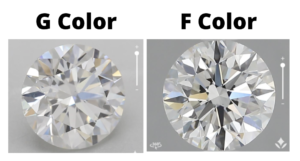
If they weren’t labeled, you likely wouldn’t know they earned different grades.
But some buyers desire the satisfaction of a colorless diamond. They want to maximize its qualities across the four Cs and may ensure their diamond has grades like an excellent cut and flawless or VVS clarity.
Even though they appear similar, there’s intangible value to a higher quality diamond.
Additionally, you might decide on an F versus G diamond based on the diamond’s weight.
If you’ve chosen a two- or three-carat diamond, be mindful you’ll have to choose a higher color grade for it to appear colorless.
As an example, this round-cut weighs 2.80 carats and earned a G color grade.
You’ll notice the yellow tints are apparent on its edges.
There are still instances in which a G diamond will appear colorless at those carat weights, but it’s worth viewing it in-person or through a high-quality image to be certain.
3. G Color Diamonds are More Popular for Engagement Rings
G is often the most popular color for engagement ring diamonds because it strikes the balance between appearing colorless and avoiding the premiums charged for higher grades.
Unlike F color diamonds, it sits outside the colorless category. So there’s a disproportionate drop in price compared to its value and appearance.
Check out this engagement ring in 18K white gold with a G diamond.
It’s surrounded by a halo of small diamonds and pave on the shank.
The color of those accents are G and H, so the center diamond isn’t dull in comparison.
That’s an important tip for engagement rings with a G color.
Be mindful of the colors of additional diamonds on the ring. If they’re graded D or E, the larger stone may show yellow in comparison.
But if you’ve chosen a solitaire diamond ring with a G grade, don’t worry about any contrast.
Even though a G color diamond is a common choice, don’t start your search there.
Instead, you can also find value at H, J or I color grades, depending on its weight and cut.
For example, this diamond earned an H color grade and likely appears colorless to the naked eye.
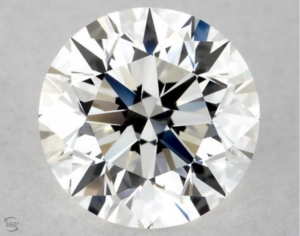
Remember, your goal isn’t to choose a specific color grade for your engagement ring.
Focus on how it appears to the naked eye, and aim for value from there.
Are There any Similarities?
Choice of Setting
Consider a lower color grade if your diamond ring is set in yellow or rose gold, like in the setting below.
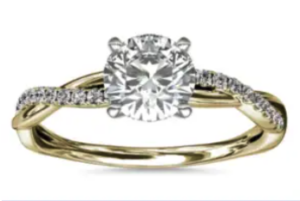
The color from those settings has the potential to make the diamond appear darker no matter its color, so it’s not always worth the high color grade.
You could choose H or I for the same result.
But G and F diamonds are an exceptional fit for white gold or platinum settings if you’re interested in those higher grades.
Fancy Shapes
The other similarity is their popularity for fancy shapes.
Cuts like emerald, baguette, and Asscher show more color because of step-cut facets. Instead of exhibiting strong light performance, they have a subtle glow that doesn’t disguise hints of yellow.
For example, in the emerald cut below is graded H.
While that grade often appears colorless for round diamonds, notice the subtle yellow that’s apparent in the step-cut facets.
For it to appear colorless like a J or I brilliant cut, you may have to move up the scale to G or F.
The additional cost of this higher color grade is offset by the lower cost-per-carat for step cuts compared to round diamonds.
Rarity
Most diamonds are discovered with strong shades of yellow and brown.
It’s uncommon for miners to find one with only slight tints of color, much less a gem that appears colorless without magnification.
In fact, less than one percent of diamonds are truly colorless.
So both G and F color diamonds are rare, which explains the price premium compared to ones in the “faint,” “very light,” and “light” categories.
How to Decide Between F and G Diamonds
Comparing F versus G diamonds requires understanding how that difference in color grade affects its appearance and performance.
Although they sit side by side on the color scale and appear similar, it’s important to choose the diamond that’s right for you.
To help you decide, here are some questions to ask:
- Do you want to avoid the premiums charged for a colorless diamond?
- Is the satisfaction of a colorless diamond essential to you?
- Could you find a diamond with the same appearance at a lower grade, which could result in better value?
- Is the diamond more than two carats, which could show more color compared to smaller ones?
- What type of setting will hold the diamond, and will its metal cause the center diamond to appear colorless or show tints of yellow?
Check out F and G diamonds at in-person and online jewelry vendors. By viewing them in the store or through high-resolution images, you’ll learn how each color grade performs.
Whether you land on F, G, or a diamond with another grade, you’ll have the confidence it’s the best fit for you.
Exploring F & G Color Diamonds: A Detailed Q&A Section
Q1: What is the primary distinction between F and G color diamonds on the GIA scale?
A1: The primary distinction is that F color diamonds are classified as colorless, while G color diamonds fall into the near colorless category on the GIA scale, indicating a slight but discernible difference in color.
Q2: How do F and G color diamonds compare in terms of price, and what factors contribute to the price disparity?
A2: F color diamonds tend to be priced higher than G color diamonds due to their classification as colorless. The price disparity reflects the rarity and demand for colorless or near colorless diamonds.
Q3: What is the impact of magnification on the perception of color in F and G color diamonds?
A3: Magnification can make it easier to detect color differences. However, the color distinctions between F and G color diamonds may still be subtle and often require a trained eye to identify.
Q4: How do the colors of F and G diamonds compare when they are set in different types of metals?
A4: F and G color diamonds may appear more colorless in white metal settings, while yellow or rose gold settings might bring out a warmer tone, making the color difference more noticeable.
Q5: How does the color of a diamond affect its overall value, especially in the case of F and G color diamonds?
A5: The color significantly impacts a diamond’s value. F color diamonds, being in the colorless category, are often valued higher than G color diamonds, which are in the near colorless category.
Q6: What are the key considerations for buyers when deciding between an F and G color diamond?
A6: Buyers should consider their budget, the setting and design of the jewelry, the size and shape of the diamond, and personal preference regarding color when deciding between an F and G color diamond.
Q7: How might the shape and cut of a diamond influence the perceived color, especially in F and G color diamonds?
A7: The shape and cut can affect how color is reflected and perceived. Some shapes and cuts may mask color better, while others may make color differences more apparent.
Q8: Are there any common misconceptions regarding the color grading of diamonds, particularly in the near colorless and colorless categories?
A8: A common misconception is that diamonds in the near colorless category appear visibly colored, when in fact, the color differences are often subtle and may not be easily noticeable to the untrained eye.
Q9: What is the significance of the colorless category in the GIA color scale, and how do F color diamonds fit into this category?
A9: The colorless category represents the highest quality in terms of color grading, and F color diamonds are within this category, indicating an absence or near absence of color.
Q10: How might personal preference and aesthetic appeal factor into the choice between F and G color diamonds?
A10: Personal preference plays a significant role. Some individuals may prefer the pristine appearance of colorless diamonds, while others may find the warmer tone of near colorless diamonds appealing, especially depending on the setting and design of the jewelry.

Jacob Clarke
Jacob Clarke is the founder of TeachJewelry.com.
He earned an Applied Jewelry Professional Diploma from the Gemological Institute of America (GIA) and now brings you essential information about diamonds, settings, and more.
Jacob has consulted with leading jewelry brands, and his work has been cited in Clean Origin, Diamond Nexus and industry publications.
He's also a member of the International Gem Society.
He enjoys discussing jewelry with readers, so contact him with any questions at jacob.clarke@teachjewelry.com.

